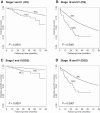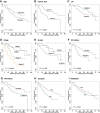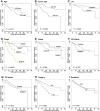Invasive neuroendocrine carcinoma of the breast: a population-based study from the surveillance, epidemiology and end results (SEER) database
- PMID: 24589259
- PMCID: PMC3974013
- DOI: 10.1186/1471-2407-14-147
Invasive neuroendocrine carcinoma of the breast: a population-based study from the surveillance, epidemiology and end results (SEER) database
Abstract
Background: Neuroendocrine carcinoma (NEC) of the breast is a rare type of carcinoma that has not been well studied or characterized. Of the limited number of studies reported in the literature, most are case reports. A few small retrospective series studies have been reported.
Methods: We reviewed data on 142 cases of mammary NEC recorded in the surveillance, epidemiology, and end results (SEER) database during 2003-2009 and evaluated disease incidence and patient age, sex, and race/ethnicity; clinicopathologic characteristics; and survival in comparison to invasive mammary carcinoma, not otherwise specified. We also performed univariate and multivariate analyses to identify prognostic factors in this disease.
Results: Review of the 142 SEER cases revealed that NEC is an aggressive variant of invasive mammary carcinoma. It generally occurred in older women (>60 years); present with larger tumor size (>20 mm), higher histologic grade, and higher clinical stage; and result in shorter overall survival and disease-specific survival than invasive mammary carcinoma, not otherwise specified (IMC-NOS). Overall survival and disease-specific survival were shorter in NEC at each stage than in IMC-NOS of the same stage. Furthermore, when all NEC and IMC-NOS cases were pooled together, neuroendocrine differentiation itself was an adverse prognostic factor independent of other known prognostic factors, including age, tumor size, nodal status, histologic grade, estrogen/progesterone receptor status, and therapy.
Conclusions: NEC is a rare but aggressive type of mammary carcinoma. Novel therapeutic approaches should be explored for this uniquely clinical entity.
Figures




References
-
- Cubilla AL, Woodruff JM. Primary carcinoid tumor of the breast: a report of 8 patients. Am J Surg Pathol. 1977;1:283–292. doi: 10.1097/00000478-197712000-00001. - DOI
-
- Fisher ER, Palekar AS. Solid and mucinous varieties of so-called mammary carcinoid tumors. Am J Clin Pathol. 1979;72(6):909–916. - PubMed
-
- Papotti M, Macri L, Finzi G, Capella C, Eusebi V, Bussolati G. Neuroendocrine differentiation in carcinomas of the breast: a study of 51 cases. Semin Diagn Pathol. 1989;6(2):174–188. - PubMed
MeSH terms
Grants and funding
LinkOut - more resources
Full Text Sources
Other Literature Sources
Medical
Research Materials

